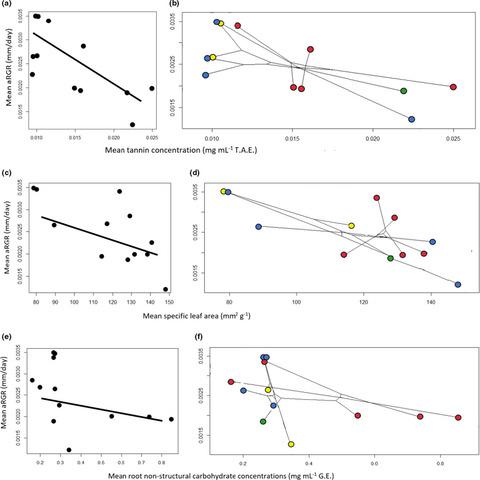当前位置:
X-MOL 学术
›
Ecol. Evol.
›
论文详情
Our official English website, www.x-mol.net, welcomes your feedback! (Note: you will need to create a separate account there.)
Herbivore-induced defenses are not under phylogenetic constraints in the genus Quercus (oak): Phylogenetic patterns of growth, defense, and storage
Ecology and Evolution ( IF 2.6 ) Pub Date : 2021-04-06 , DOI: 10.1002/ece3.7409 Cynthia Perkovich 1 , David Ward 1
Ecology and Evolution ( IF 2.6 ) Pub Date : 2021-04-06 , DOI: 10.1002/ece3.7409 Cynthia Perkovich 1 , David Ward 1
Affiliation

|
The evolution of plant defenses is often constrained by phylogeny. Many of the differences between competing plant defense theories hinge upon the differences in the location of meristem damage (apical versus auxiliary) and the amount of tissue removed. We analyzed the growth and defense responses of 12 Quercus (oak) species from a well-resolved molecular phylogeny using phylogenetically independent contrasts. Access to light is paramount for forest-dwelling tree species, such as many members of the genus Quercus. We therefore predicted a greater investment in defense when apical meristem tissue was removed. We also predicted a greater investment in defense when large amounts of tissue were removed and a greater investment in growth when less tissues were removed. We conducted five simulated herbivory treatments including a control with no damage and alterations of the location of meristem damage (apical versus auxiliary shoots) and intensity (25% versus 75% tissue removal). We measured growth, defense, and nutrient re-allocation traits in response to simulated herbivory. Phylomorphospace models were used to demonstrate the phylogenetic nature of trade-offs between characteristics of growth, chemical defenses, and nutrient re-allocation. We found that growth–defense trade-offs in control treatments were under phylogenetic constraints, but phylogenetic constraints and growth–defense trade-offs were not common in the simulated herbivory treatments. Growth–defense constraints exist within the Quercus genus, although there are adaptations to herbivory that vary among species.
中文翻译:

草食动物诱导的防御作用不受栎属(橡树)的系统发育限制:生长,防御和贮藏的系统发育模式
植物防御的进化通常受到系统发育的限制。相互竞争的植物防御理论之间的许多差异取决于分生组织损伤(顶端与辅助)的位置和切除的组织数量的差异。我们使用系统发生学独立的对比分析了一个良好解析的分子系统发育学中的12个栎类(橡树)的生长和防御反应。对于像林栎属(Quercus)的许多树木这样的森林树木而言,光的获取是最重要的。。因此,我们预计当根尖分生组织被去除时,在防御方面的投资将更大。我们还预测到,当去除大量组织时,在防御方面的投资会更大;而当去除更少的组织时,在生长方面的投资会更大。我们进行了五次模拟的草食动物治疗,包括无损伤且分生组织损伤位置(顶端芽与辅助芽)和强度(25%相对于75%的组织去除)发生变化的对照。我们对模拟草食动物的生长,防御和养分重新分配特征进行了测量。系统形态空间模型用于证明生长,化学防御和养分重新分配之间的权衡取舍的系统发育性质。我们发现,控制治疗中的生长防御权衡是在系统发育限制下进行的,但是在模拟的草食动物治疗中,系统发育的限制和生长防御的折衷并不常见。国防增长存在制约因素栎属,尽管对草食动物的适应因物种而异。
更新日期:2021-05-19
中文翻译:

草食动物诱导的防御作用不受栎属(橡树)的系统发育限制:生长,防御和贮藏的系统发育模式
植物防御的进化通常受到系统发育的限制。相互竞争的植物防御理论之间的许多差异取决于分生组织损伤(顶端与辅助)的位置和切除的组织数量的差异。我们使用系统发生学独立的对比分析了一个良好解析的分子系统发育学中的12个栎类(橡树)的生长和防御反应。对于像林栎属(Quercus)的许多树木这样的森林树木而言,光的获取是最重要的。。因此,我们预计当根尖分生组织被去除时,在防御方面的投资将更大。我们还预测到,当去除大量组织时,在防御方面的投资会更大;而当去除更少的组织时,在生长方面的投资会更大。我们进行了五次模拟的草食动物治疗,包括无损伤且分生组织损伤位置(顶端芽与辅助芽)和强度(25%相对于75%的组织去除)发生变化的对照。我们对模拟草食动物的生长,防御和养分重新分配特征进行了测量。系统形态空间模型用于证明生长,化学防御和养分重新分配之间的权衡取舍的系统发育性质。我们发现,控制治疗中的生长防御权衡是在系统发育限制下进行的,但是在模拟的草食动物治疗中,系统发育的限制和生长防御的折衷并不常见。国防增长存在制约因素栎属,尽管对草食动物的适应因物种而异。



























 京公网安备 11010802027423号
京公网安备 11010802027423号